Instagram is a robust social media forum with more than 1 billion monthly active users, but success depends on understanding how to harness its visual power.
What do photo sharing and the pharmaceutical industry have in common? The answer is a lot more than you might expect. Instagram has become an important way to connect with various audiences, particularly younger, visually oriented consumers and patients.
The social forum was launched in 2010 and was acquired by Facebook in 2012. Recent statistics show Instagram had more than 1 billion monthly 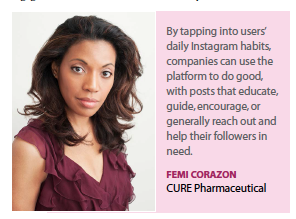 active users and 25 million business profiles, with more than 200 million users visiting a business profile each day.
active users and 25 million business profiles, with more than 200 million users visiting a business profile each day.
“The Instagram audience is known for being mobile and very visually oriented, and generally engaging those in the 18 to 30 age range," says Ellen Gerstein, director digital content, Pfizer. “Instagram gives us a way to creatively story-tell around our pipeline and engage with our followers in a different way."
Femi Corazon, creative strategy director for CURE Pharmaceutical says Instagram has unlimited potential to reach an audience that actively seeks out storytelling in all forms. Instagram users readily embrace authentic content that connects on an emotional level. Since customers are on Instagram, that’s where companies need to be, she says.
“By tapping into users’ daily Instagram habits, companies can use the platform to do good, with posts that educate, guide, encourage, or generally reach out and help their followers in need," Ms. Corazon says.
Exploring the Power of Instagram
Companies leading the social media charge recognize that each forum has its benefits. Pfizer, for example, uses Facebook for more consumer-oriented, patient policy, and R&D content, while Twitter is the ideal platform for breaking news, and LinkedIn is a good medium to talk about the company’s people and science.
“Instagram is really about the quality and uniqueness of the photo," Ms. Gerstein says. “Instagram reaches young people who are on their phones, on the go, looking at a picture, and scrolling through their feed. They’re not in a post looking to go elsewhere, so don’t typically use posts to drive to a website or a call to action. We engage followers on the platform and that’s where they expect to make the connection. Our Instagram posts will include 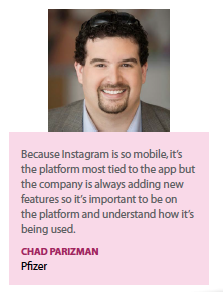 something about one of our breakthroughs, or a photo of a new molecule in our Beyond the Naked Eye series."
something about one of our breakthroughs, or a photo of a new molecule in our Beyond the Naked Eye series."
Pfizer serialized its Cure Hunters and Dear Scientist campaigns using Instagram stories, with three or four panels talking about the campaign and the option to link to see a longer video or a more in-depth story.
According to Andrew Abdel-Malik, head, group social media content and channels, Novartis, Instagram helps the organization reach audiences in a meaningful, authentic, and fun way.
“An image is exponentially powerful when talking about a personal and emotional subject such as health on a smartphone in the palm of your hand," Mr. Abdel-Malik says.
The power of Instagram lies also in its reach. For example, Nancy Nolan, associate director, marketing communications/channels, adult vaccines multi channel promotion, Merck, says the company uses the platform to amplify key disease facts, conduct geo-targeting around college campuses, and reach audiences leading up to events such as musical festivals, as well as partnering with influencers.
Consumers and patients find Instagram a good forum to openly share their experiences with certain conditions or treatments and chronicle their experience with their followers, says Nikki Wolfert, associate director, social media, at Intouch Media.
“If done tactfully, a brand can harness this passion that patients or caregivers demonstrate and help activate and unite the community," she says. “And, this requires a strategic approach.
“For one of our clients, we found that we were reaching a majority of their 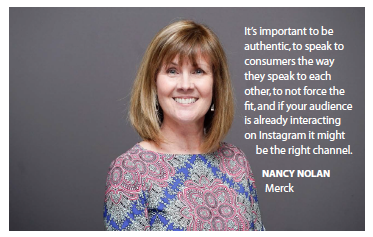 audience on Facebook, but they really wanted to shift gears and engage with a younger female audience," Ms. Wolfert continues. “After some initial social listening, we found a significant amount of branded conversation was occurring on Instagram, both by the younger female audience and by HCPs. Conducting ongoing social listening helps us keep our finger on the pulse of conversation relevant to our client’s brand and audience, and we regularly incorporate learnings into our content development."
audience on Facebook, but they really wanted to shift gears and engage with a younger female audience," Ms. Wolfert continues. “After some initial social listening, we found a significant amount of branded conversation was occurring on Instagram, both by the younger female audience and by HCPs. Conducting ongoing social listening helps us keep our finger on the pulse of conversation relevant to our client’s brand and audience, and we regularly incorporate learnings into our content development."
Instagram can be very useful in promoting awareness of disease, as well as alternative ways to deliver treatments. Ms. Corazon says a great example of this is the recent explosion of public interest in cannabis-based medicines. There is a large community on social media of medical cannabis users and people who are interested in learning more about cannabis and how it can help with their ailments.
“Social sharing and peer-to-peer conversations on platforms such as Instagram do a lot to de-stigmatize alternative approaches like cannabis for which people may have misgivings or apprehensions," she says.
Another opportunity that Instagram provides companies is the ability to share user-generated content. Pharma companies can leverage this feature and facilitate the sharing of follower stories to help spread awareness about any given topic, she says.
The Social Media Conundrum
In a highly regulated environment such as the pharmaceutical industry, there will always be challenges to using a medium such as Instagram, which is a fluid, real-time, and highly interactive channel, Ms. Nolan says.
Julia Stern, senior strategy analyst at Merkle, says while Instagram is an exciting territory, it is a difficult space for pharma brands to navigate, so the team is still investigating the platform’s potential.
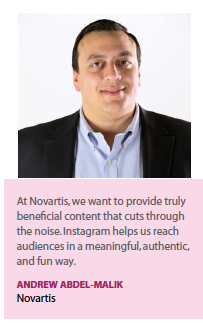 “We are not alone — there have been few brands in the category to attempt branded campaigns, citing problems displaying safety information and breaking through the clutter of miracle cures and pop-science remedies," she says.
“We are not alone — there have been few brands in the category to attempt branded campaigns, citing problems displaying safety information and breaking through the clutter of miracle cures and pop-science remedies," she says.
Ms. Wolfert agrees that Instagram presents some challenges to providing required safety information, so Intouch Media has had to get creative with how to fulfill this regulatory requirement while still being social, on social.
“We’ve used and seen several tactics such as including scrolling ISI videos on the end frame of an Instagram carousel post or launching safety-only Instagram handles, so that branded post copy can include a clickable handle link and users can easily access the full safety information," she says.
According to Rocco Albano, VP, experience strategy, Merkle, another challenge is that pharma struggles with empathetic messaging and marketing, making it even more difficult for it to succeed in social.
“Complex and overly clinical messaging and experiences are a non-starter, especially in a space where people don’t necessarily see themselves as patients and speak freely — regardless of accuracy — about their experience with a brand or treatment," he says.
Ms. Corazon says Instagram Stories is a powerful feature that offers pharma companies additional opportunities to share behind-the-scenes content and live stories, and foster engagement with their followers with calls-to-action and other pertinent messaging.
It’s important to work out a strategy with Instagram Stories before rushing in, Ms. Gerstein says. For its part, Pfizer looked at influencers in other spaces — fashion, people in political spheres, National Geographic — to name a few.
“We saw that people were using the stories in very different ways and it gave us a lot of ideas about the way that we could story-tell and make it authentic," she says.
“Today, our stories are among our highest-rated posts across any social media."
Again with Instagram TV, Pfizer is taking its time to discuss ideas before leaping in.
“We haven’t published content there yet, but we do have some campaigns that we’re looking to launch in first quarter of this year," Ms. Gerstein says. “We’re looking at different ways to do more content around events, be those medical meetings or influencer events."
Instagram Must-Dos
There are some universal truths of Instagram campaigns that experts point to, No. 1 of which is that Instagram begins and ends with a powerful photo.
“It’s important to use fun, fresh, engaging photos," Ms. Gerstein says. “Pictures need to jump out of the feed and get people’s attention. I think our Beyond the Naked Eye series has done this. We’ve captured people who are interested in science with a closeup image of a molecule or a virus."
Also, captions can’t be too long or too short, Ms. Gerstein adds. “This is Goldilocks’ territory — you want to give just enough information but not too much to put people off."
Ms. Corazon says in order to be effective on Instagram it’s valuable to know your audience, understand what they want to see, how they interact, and who they like and trust.
In addition, since the platform’s algorithm can cause some content to become less visible to followers, consistent posting, as well as frequent interaction with followers encourages continuous follower engagement — which in turn increases visibility.
“On a more tactical level, social media content creators should consider the purpose and intended placement of the assets they’re creating: where is it going to live?" she advises. “It doesn’t really work to create one asset and put it on all platforms. It’s more effective to create posts specifically for Instagram."
For Novartis, finding out what works best with Instagram involves: test, learn, and repeat. “We find Instagram stories offer a light and fun way to approach social media," Mr. Abdel-Malik says.
Mr. Albano says brands should take a page from unbranded campaigns, which use short-form content that leads to a separate Web experience.
“This approach allows the creative to fit in with Instagram’s snackable content, while still providing important detailed information to consumers," he says.
Content needs to stand out as users are scrolling through a crowded feed, it needs to be unique, and it needs to acknowledge the fact that people use Instagram in a very different way from Facebook or Twitter, Ms. Wolfert says.
Authenticity is key, experts say. “Speak to consumers the way they speak to each other — as much as possible — and don’t force the fit as it may not be the right channel for all pharma brands," Ms. Nolan says.
Brands also need to build a social presence that goes beyond marketing a product and promote experiences that help people manage their condition and connect with healthcare professionals, associations, communities, and others across the entire treatment journey, Merkle’s Ms. Stern says.
“Thoughtfully leveraging social influencers can help establish credibility and trust," she says.
It’s also important to have a platform owner, says Chad Parizman, head of social media and digital communications, Pfizer.
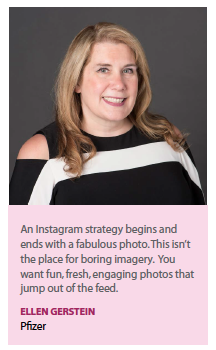 “Instagram is always adding new features so you need to be in the platform and understand how brands and people are using it," Mr. Parizman says. “It’s about understanding the sociology of the platform."
“Instagram is always adding new features so you need to be in the platform and understand how brands and people are using it," Mr. Parizman says. “It’s about understanding the sociology of the platform."
Having a solid library of content to draw upon and seeking ways to efficiently capture content for short gifs and teasers is important, Ms. Nolan says.
And use tools, such as emojis, hashtags, geotags, and stories. “Users expect brands to use these features, and pharma brands are no exception, plus, they’re all known to help boost engagement," Ms. Wolfert says.
Paid amplification is also a must. “Brands that thoughtfully apply a moments-based approach and go bigger when key moments warrant will ultimately win out in the end," Ms. Wolfert adds.
For successful Instagram campaigns, companies need to identify their campaign goals before creating assets, Ms. Corazon says.
“For example: Is it to gain more followers? Increase brand awareness? Promote a specific product? Drive people to a website? And how will success be measured? The answers to these questions will inform the best approach for an Instagram campaign that is aligned with your overall business goals."(PV)
~~~~~~~~~~~~~~~~~~~~~~~~~
Instagram Strategies
Instagram is being used by pharma companies in various ways to reach the patient audience. Our subject matter experts discuss how they are using Instagram.
 Andrew Abdel-Malik
Andrew Abdel-Malik
Head, Group Social Media Content and Channels, Novartis
One of the ways Novartis has used Instagram to engage patients and the public directly is by tapping into how those audiences are already using the platform.
An example is the Novartis Kiss This 4 MBCTM initiative, a U.S. campaign that uses social media to raise visibility and research funds for metastatic breast cancer (MBC), an incurable form of breast cancer. The campaign, which initially launched in 2017, encouraged the public to share a selfie or Boomerang on social media with the hashtag #KissThis4MBC, and for each post Novartis made a donation to support MBC research.
While people could participate on Facebook, Twitter, or Instagram, the highest organic participation was seen on Instagram. During the two years that the campaign has been running, we’ve seen people participating in creative and unique ways that we could have never imagined — raising more than $400,000 for MBC research to date through over 33,000 posts shared on social media.
 Femi Corazon
Femi Corazon
Creative Strategy
Director,
CURE Pharmaceutical
We started using Instagram fairly recently and we’re experimenting with different content forms to see what our followers prefer to engage with.
One strategy that’s proven to be successful for us is reposting relevant content from our partners and trusted third-party sources we respect. We want to help our customers be more informed about innovations in medicine, the benefits provided by CUREfilm technology, and the scientific reasons behind why our technology is better, so we try to point them in the right directions to sift through the noise and find the answers themselves. In general, we strive to maintain a nimble approach with social media since we’re learning about our followers every day and want to adjust our strategy accordingly.
 Ellen Gerstein
Ellen Gerstein
Director of Digital Content, Pfizer
We recently did an Instagram campaign around NASH (non-alcoholic fatty liver disease), which is a condition that’s important from a health perspective and an important focus for our pipeline.
The campaign gave us an opportunity to story-tell in a different way to raise awareness to our audience about what the condition is. In the Instagram post, we used a cutdown video about NASH to explain the condition, which can be a bit difficult to understand. We had great visualization of the condition showing how NASH affects the liver. Then we did a longer Instagram story about NASH, and asked questions to make the experience more interactive, such as: Do you know what NASH is? Are you aware of the condition?
 Nancy Nolan
Nancy Nolan
Associate Director, Marketing Communications/Channels, Adult Vaccines Multi Channel Promotion, Merck
Instagram was the right choice for the Versed on HPV campaign, given the 19- to 26-year-old audience we were looking to reach. We needed to engage with them where they are spending time and looking at content, and we also needed to engage them in an HPV conversation that is authentic and on their terms.


















